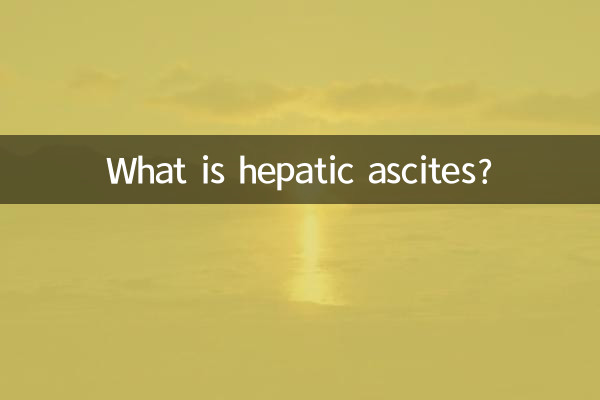What is hepatic ascites?
Hepatic ascites, also known as cirrhotic ascites, is one of the common complications in patients with liver cirrhosis. It refers to a pathological phenomenon in which excessive fluid accumulates in the abdominal cavity due to severe damage to liver function. Hepatic ascites not only affects the patient's quality of life, but may also cause other serious complications, such as spontaneous bacterial peritonitis, hepatorenal syndrome, etc. This article will introduce in detail the causes, symptoms, diagnosis and treatment of hepatic ascites, and combine it with hot topics and hot content on the Internet in the past 10 days to help readers fully understand this disease.
1. Causes of liver ascites

The main cause of hepatic ascites is cirrhosis, but other liver diseases or systemic diseases may also cause ascites. The following are common causes:
| Cause type | specific disease or factor |
|---|---|
| Liver disease | Cirrhosis, liver cancer, hepatitis (hepatitis B, hepatitis C, etc.) |
| systemic disease | Heart failure, nephrotic syndrome, malnutrition |
| other factors | Portal hypertension, hypoalbuminemia |
2. Symptoms of liver ascites
The symptoms of hepatic ascites vary depending on the severity of the disease. They may not be obvious in the early stage, but as the amount of ascites increases, the symptoms will gradually worsen. The following are common symptoms:
| Symptom classification | Specific performance |
|---|---|
| abdominal symptoms | Abdominal distension, bloating, and abdominal pain |
| systemic symptoms | Fatigue, loss of appetite, weight loss |
| Symptoms of complications | Difficulty breathing (large amounts of ascites compressing the chest), edema of the lower limbs |
3. Diagnosis of hepatic ascites
The diagnosis of hepatic ascites requires a combination of medical history, physical examination, and laboratory tests. The following are commonly used diagnostic methods:
| diagnostic methods | Specific content |
|---|---|
| Physical examination | Abdominal percussion dullness and shifting dullness were positive |
| Imaging examination | B-ultrasound, CT, MRI |
| laboratory tests | Ascites puncture (analyzing the nature of ascites), liver function tests |
4. Treatment of liver ascites
The goals of treatment for hepatic ascites are to reduce the amount of ascites, improve symptoms, and prevent complications. The following are common treatments:
| Treatment | Specific measures |
|---|---|
| drug treatment | Diuretics (such as spironolactone, furosemide), albumin infusion |
| abdominal puncture | Puncture and drainage when there is a large amount of ascites |
| surgical treatment | Transjugular intrahepatic portosystemic shunt (TIPS), liver transplantation |
5. The relationship between hot topics on the Internet in the past 10 days and hepatic ascites
Recently, topics related to hepatic ascites have sparked widespread discussion on social media and health forums. The following is the hot content in the past 10 days:
| hot topics | Related content |
|---|---|
| Liver disease prevention and treatment publicity | Free liver disease clinics are launched in many places, emphasizing early screening of hepatic ascites |
| New drug research and development progress | New diuretic for cirrhotic ascites enters clinical trials |
| Patient story sharing | Many patients with liver cirrhosis share their experience of fighting liver ascites, which resonates |
6. Prevention and life suggestions
The key to preventing hepatic ascites is to protect liver health. Here are some life suggestions:
| Suggested categories | Specific content |
|---|---|
| diet | Low-salt diet, moderate protein intake, and avoidance of alcohol |
| living habits | Maintain a regular schedule, avoid staying up late, and exercise moderately |
| Regular inspection | Patients with liver disease should regularly review liver function and abdominal B-ultrasound |
Hepatic ascites is a serious liver complication, but through scientific treatment and a healthy lifestyle, the condition can be effectively controlled. If you or your family members develop relevant symptoms, please seek medical treatment promptly to avoid delaying treatment.

check the details

check the details